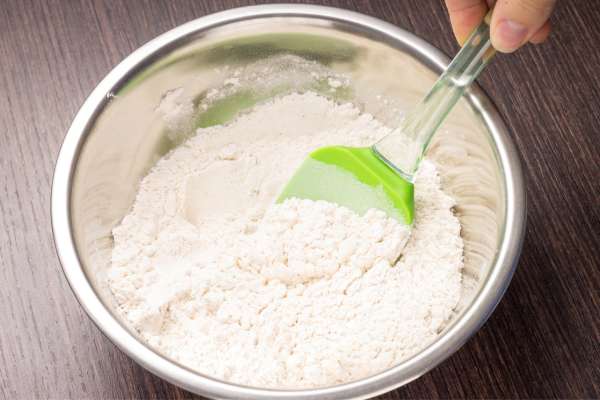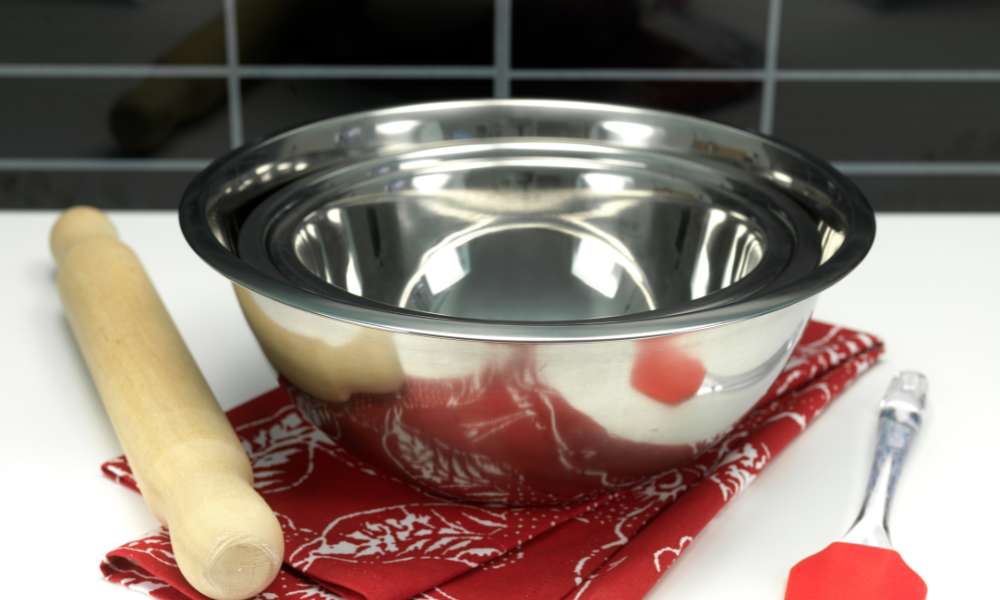Culinary preparations, The decision of when not to use metal mixing bowls Is essential for any kitchen enthusiast. These bowls, known for their durability And versatility, are not always the ideal choice For every cooking or baking situation. Understanding The specific scenarios where metal bowls might be less suitable Can greatly enhance your culinary experience. Whether it’s due To chemical reactions with certain ingredients, Temperature sensitivity, or compatibility with kitchen appliances, being aware of these limitations Is crucial. This knowledge not only protects the integrity of your dishes but also extends The lifespan of your kitchenware, making It An invaluable aspect of proficient cooking and baking.
What Are Metal Mixing Bowls?

Metal mixing bowls are A staple in many kitchens, valued For their durability and versatility. These bowls, typically made from stainless steel, are known For their resilience against staining And rust, making them An excellent choice For a variety of kitchen tasks. Their sleek and shiny appearance adds An aesthetic appeal, while their lightweight nature makes them easy to handle. Their suitability varies depending on the cooking or baking task at hand, highlighting The importance of selecting the right tool For each culinary endeavor.
Read More: How Many Mixing Bowls Do I Need
How Do I Choose The Right Mixing Bowl?

Choosing the right mixing bowl requires consideration of The task, ingredients, and desired outcome. When selecting A bowl, it’s essential to consider the material’s reaction with certain ingredients. For instance, metal bowls are not ideal For Acidic foods like tomatoes or citrus, as The metal Can react with the acidity, leading to a metallic taste In food. Additionally, metal bowls are not microwave-safe, limiting their use In recipes that require microwave heating. Their excellent heat conductivity, while beneficial For certain tasks like whipping egg whites, can be A drawback when dealing with heat-sensitive ingredients.
Importance Of Choosing The Right Bowl

Understanding The importance of choosing The right bowl for your culinary needs cannot be overstated. The wrong choice can lead To unsatisfactory results or even ruin A dish. For instance, when working with yeasted doughs, A non-reactive bowl such As glass or ceramic Is preferable, As the fermentation process can be affected by metal. Similarly, For recipes requiring gentle temperature control, such As melting chocolate, A metal bowl’s quick heat transfer could lead To burning or uneven melting. Recognizing these nuances ensures that each recipe Is not only executed correctly but also results in The highest quality outcome, reflecting the skill And care of the cook.
Advantages Of Metal Mixing Bowls

Metal mixing bowl offer several advantages In the kitchen, making them A popular choice for both professional chefs and home cooks. Their primary benefits include durability, lightweight design, And excellent heat conductivity, Which can be particularly useful In certain culinary applications. For example, Their ability To conduct heat quickly makes them ideal For tasks like tempering chocolate or whipping cream, where controlling The temperature Is crucial. Additionally, their sturdiness means they can withstand vigorous whisking And mixing without fear of cracking or breaking, Unlike their glass or ceramic counterparts.
Chemical Reactions With Certain Foods

It’s important To be aware of potential chemical reactions when using metal bowls with certain foods. These bowls, especially those made from reactive metals like aluminum, can interact with acidic ingredients such As citrus juices, vinegar, or tomato sauce. This interaction can lead To a metallic taste in The food and may also cause discoloration In the bowl itself. Furthermore, these chemical reactions can sometimes alter The color and flavor of The food, which is particularly noticeable In delicate dishes. To avoid these issues, it’s advisable To Use non-reactive bowls like glass or ceramic when working with acidic ingredients. By understanding these limitations, cooks can ensure that their choice of mixing bowl enhances their cooking experience rather than detracts from It.
Temperature Sensitivity
The temperature sensitivity of metal mixing bowl Is a double-edged sword In the culinary world. On one hand, their excellent heat conductivity makes them ideal For tasks that require quick temperature changes. For example, placing A metal bowl over A pot of simmering water creates The perfect setup For a double boiler, useful in melting chocolate or making custards. Similarly, their ability To quickly become cold when chilled In a refrigerator or freezer makes them excellent For whipping cream or preparing cold desserts. This same property can be a disadvantage when working with heat-sensitive ingredients or recipes that require steady, gradual temperature changes.
Electronic Mixer Compatibility
In terms of electronic mixer compatibility, metal mixing bowl are generally A good match. Their robustness can withstand The vigorous action of An electric mixer, making them suitable For Tasks like kneading dough or mixing thick batters. The smooth surface of metal bowls also helps in easy cleaning of sticky substances, A common challenge in baking. Moreover, many metal bowls come with A lip or rim, which provides A secure grip for the mixer’s attachments, ensuring stability during the mixing process.
Microwave Use
It’s crucial to note that metal mixing bowl are not suitable for microwave use. Metal can reflect microwaves, Causing sparks And potentially damaging the microwave or The bowl itself. This limitation means that recipes or techniques requiring microwave heating cannot be performed In metal bowls. Cooks need to opt for microwave-safe alternatives like glass or ceramic bowls For such tasks. This restriction emphasizes the importance of choosing The right bowl based on The cooking method and appliance compatibility
Alternatives To Metal Mixing Bowls
1. Glass

Glass bowls are A popular alternative due To their non-reactive nature. This means they won’t interact with acidic foods, making them ideal For recipes involving citrus, vinegar, or tomatoes. Glass bowl are also microwave-safe, offering versatility In preparation methods that metal bowls cannot. Additionally, their transparency is A practical advantage, Allowing cooks To easily monitor The progress of what they’re mixing. Glass bowls are also known for their heat-resistant properties, making them safe for use In both microwaves And ovens. They can be heavier And more fragile than metal bowl, So Handling them with care is essential.
2. Ceramic

Ceramic bowls are another excellent alternative, known For their aesthetic appeal And wide variety in designs And colors. Like glass, they are non-reactive and safe to use with Acidic ingredients. Ceramic bowls often have a weight And sturdiness that provide stability during mixing, especially useful for heavy doughs. They are also typically oven-safe, Making them suitable For recipes that require baking directly In the bowl. They Can be quite heavy and are susceptible To Cracking or chipping if dropped. Additionally, ceramic bowls Can retain heat for A longer period, which is beneficial for certain recipes but might require caution In handling after being exposed To high temperatures.
3. Plastic

Plastic bowls are A lightweight and highly versatile alternative to metal mixing bowls. One of their main advantages is their durability – they are less likely To break or chip compared To glass or ceramic. This makes them a great option for high-traffic kitchens or For tasks that require moving the bowl around frequently, such as outdoor cooking. Plastic bowls are often microwave-safe, adding to Their versatility. It’s important to choose high-quality, food-grade plastic To Avoid any potential chemical leaching, especially when used with hot ingredients. Another consideration is that plastic can absorb odors and stains from strong-flavored foods, which could be a downside for some users. They’re also prone To scratching, which could harbor bacteria If Not properly cleaned.
4. Silicone

Silicone bowls are A Relatively new entrant in The kitchen but have quickly become popular due to their unique set of properties. They are extremely flexible, which Can be a significant advantage for tasks like pouring batter into A Baking pan or folding delicate ingredients. Silicone Is also heat-resistant, making these bowl suitable for use In microwaves and ovens, And they can withstand extreme cold, perfect for chilling preparations. Additionally, silicone bowl are non-reactive And won’t absorb odors or flavors, making them suitable For A variety of ingredients. They’re also typically very easy to clean and can be collapsed For storage, saving space In the kitchen. Their flexibility might be A disadvantage For heavy-duty mixing tasks, As they lack the rigidity of metal, glass, or ceramic bowls.
Can Metal Bowls Affect Allergies?
The impact of metal bowls on allergies Is a pertinent concern, particularly For individuals with specific metal sensitivities. Generally, high-quality stainless steel bowls are considered safe As They are non-reactive And don’t harbor allergens. Bowls made from metals like nickel or aluminum may pose risks For those with certain allergies. Nickel, A Common allergen, Can be present in some metal alloys And may cause reactions In Sensitive individuals. While The risk of allergic reaction from kitchenware Is typically low, those with known metal allergies should exercise caution. And perhaps opt For alternative materials like glass, ceramic, or silicone To ensure A safe cooking environment free from potential allergens.
Conclusion
While metal mixing bowls are a versatile And durable option. For many kitchen tasks, their impact on allergies Is minimal For The majority of the population. For those with specific metal sensitivities, particularly to nickel, caution should be exercised. Choosing The right material for kitchenware Is not only a matter of functionality. And preference but also one of health And safety. Therefore, understanding The composition and properties of your kitchen tools, including metal mixing bowls, Is Crucial in ensuring a safe And enjoyable cooking experience for everyone, especially those with allergies.
